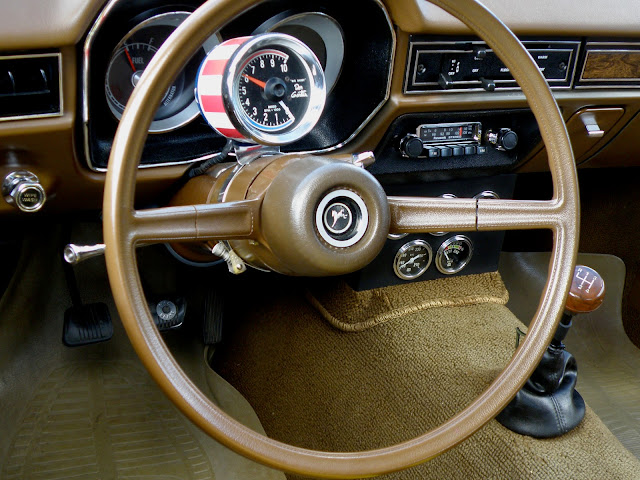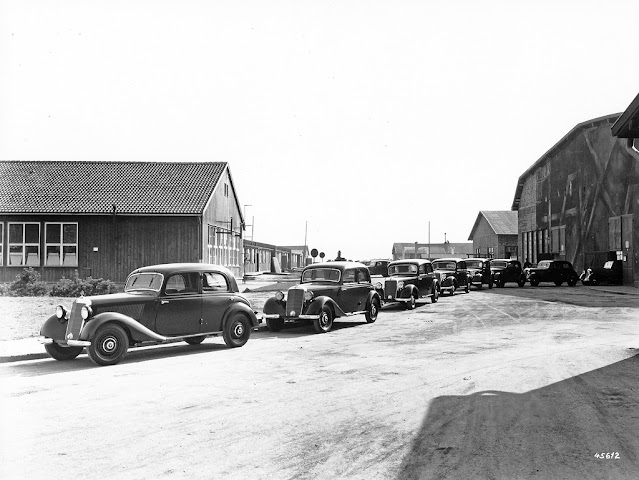Maximilian Edwin Hoffman, Mercedes Benz importer for the eastern United States of America from 31 July 1952 onwards and initiator of the 190 SL (W 121). (Photo index number in the Mercedes Benz Classic Archives: 2002DIG504)
Representation of the Hoffman Motor Car Co. in Chicago, around 1955. At that time, the company was the importer and general distributor for Mercedes Benz in the United States of America. (Photo index number in the Mercedes Benz Classic Archives: 65477)A great idea marks the beginning of the history of the Mercedes‑Benz SL series-production sports cars: Mercedes‑Benz was to transfer the fascination for luxurious sportiness to a compact roadster. That’s what Maximilian E. Hoffman, the brand’s importer for the eastern United States of America, proposed in 1953. In the dialogue which took place between the Stuttgart management and Hoffman, two sports cars were finally created: the compact 190 SL Roadster (W 121) initiated by Hoffman was technically derived by Mercedes‑Benz from the “Ponton” saloons of the upper medium-size category (W 120). In addition, the concept of the successful 300 SL racing sports car (W 194) was transferred to the high-performance 300 SL “Gullwing” (W 198) for particularly discerning customers. Both sports cars were premiered at the International Motor Sports Show in New York from 6 to 14 February 1954. The 300 SL Roadster (W 198) presented in 1957 was also as a result of Hoffman’s initiative.
The company was open to Hoffman’s visionary input, which contributed significantly to the legend of the Mercedes‑Benz SL. The two series-production sports cars from 1954 mark the beginning of a unique tradition that extends to the current 232‑series Mercedes‑AMG SL. Hoffman’s influence is therefore certainly comparable to that of Emil Jellinek a good half century earlier: by specifying his requirements, the leading dealer for Daimler-Motoren-Gesellschaft automobiles in Nice at the time provided the impetus for the design of the Mercedes 35 hp by Wilhelm Maybach.
Exports to North America take shape
The company made contact with Maximilian E. Hoffman as part of its strategy to strengthen exports to North America. Wilhelm Haspel, Chairman of the Board of Management of the then Daimler‑Benz AG, personally drove forward the positioning of the world’s oldest luxury car manufacturer in North America from the summer of 1948 onwards. He was aware that the United States in particular, with the world’s largest automobile market at the time, had an important key function for successful global exports. Commercial vehicles were also included in the considerations – and they would even be an important driver of the company’s foreign activities.
Mercedes‑Benz’s exports to North America took concrete shape in 1952. A decisive role was played by the Vienna-born Maximilian E. Hoffman, who first applied to be a Mercedes‑Benz distributor in the United States of America in March 1952. On 31 July 1952, the then Daimler‑Benz AG signed a contract with him as general distributor for the eastern USA. Sales started in December 1952, after showrooms were set up, salespeople trained and US‑specification vehicles delivered. All in all, a total of 253 Mercedes‑Benz passenger cars were exported to the United States in this first year of cooperation with Hoffman.
Hoffman’s flair for automotive luxury
Maximilian Edwin Hoffman was born in Vienna on 12 November 1904. As a businessman, he developed a great sense of fascinating and promising automobiles, combined with a pronounced sense of aesthetics, technology and driving dynamics. In the 1930s, he and a partner founded the Hoffman & Ruppert company in Vienna, which successfully imported Alfa Romeo, Bentley, Delahaye, Rolls‑Royce, Talbot and Volvo automobiles to Austria.
During the Nazi era, Hoffman, the son of a Jewish sewing machine and later motorbike manufacturer, emigrated first to France and finally to New York in 1941. After the end of the war, he succeeded in entering the business of importing European vehicles into the United States of America. Hoffman, who adapted his surname to the Anglo-Saxon spelling, presented a Delahaye in a showroom on New York’s fine Park Avenue. With his excellent taste and high workload, he secured a top position in the exclusive automobile trade in the USA. As a result, he was predestined for a role as a partner of Mercedes‑Benz in North America.
After the successful sales launch in 1952, Hoffman’s status gained additional weight for Mercedes‑Benz from May 1953: it was in this month that export director Arnold Wychodil reported to his colleagues about the importer’s assessment that a Mercedes‑Benz sports car was needed for the US market. Maximilian E. Hoffman was invited, and on 2 September 1953 he personally presented his plans in Untertürkheim to a group of the eight board members and leading employees of the company. He described the special features of the US market and, according to the board minutes, requested “under any circumstances, a sports car which alone could provide the basis for the livelihood of the dealer organisation”.
Two series production sports cars emerge
The result of the discussion was the development of prototypes for two sports cars. A special concern of Hoffman’s was for a compact, open-top sports car. The platform frame of the Mercedes‑Benz 180 (W 120) was initially envisaged as its basis. Hoffman, however, rejected a cabriolet with a long wheelbase and traditional Mercedes‑Benz radiator because this shape did not correspond to his idea of a typical European sports car. The designers and stylists in Sindelfingen responded to this assessment. In fact, the 190 SL was built with a 250‑millimetre shorter wheelbase (2,400 millimetres instead of 2,650 millimetres) on the platform of the originally envisaged Cabriolet A of the W 120 series. And it featured a large central star with a chrome-plated transverse louvre in the radiator grille – since then the typical face of the SL.
While Mercedes‑Benz pressed ahead emphatically with the series development of the 190 SL, the 300 SL Coupé was also developed at short notice as a high-performance sports car, with technology based on the 1952 racing sports car. The trade fair premiere of both sports cars in February 1954 was a sensation. The 300 SL “Gullwing” (W 198) was launched in the summer of 1954, followed in 1955 by the 190 SL (W 121), which was presented in New York as a pre-series production model. And above all, this compact roadster became Mercedes‑Benz’s big draw for sales in the USA: between 1955 and 1960, it accounted for 17.75 percent of all Mercedes‑Benz passenger cars delivered to the USA – Maximilian E. Hoffman’s estimate proved to be correct.
At the end of 1953, Hoffman became the Mercedes‑Benz general distributor for the entire United States. Hoffman Motor Car Co. expanded its sales territory for Mercedes‑Benz vehicles accordingly, with centres in New York, Chicago and Los Angeles. From the mid-1950s, Daimler‑Benz AG gradually established its own presence in North America with the subsidiaries Daimler‑Benz of North America (in New York) and Mercedes‑Benz of Canada (in Toronto). From 1965, sales were transferred to Mercedes‑Benz of North America (MBNA).
Opening of the new Classic Center in Long Beach, California
The collaboration between Mercedes‑Benz and Maximilian E. Hoffman from 1952 onwards proved to be a decisive course-setter for the future of the brand in North America. In terms of the heritage of the world’s oldest car manufacturer, another decision in the early 2000s has been similarly important: in Irvine, California, Mercedes‑Benz Classic opened its own Classic Center in 2006. It has become a beacon for the star-branded automotive classics scene in the United States of America and beyond.
On 12 and 13 August 2022, the brand will open a new chapter in this success story: the opening ceremony for the Classic Center’s new location in Long Beach, south of Los Angeles. In addition to the “Grand Opening” on 12 August, the event programme will also include a classics meeting in the series “Classics & Coffee” on 13 August.
Mercedes‑Benz Classic will also be present in summer 2022 at what is probably the most brilliant classic event in North America: on 21 August 2022, the world’s oldest luxury car manufacturer will take part in the Pebble Beach Concours d’Elegance in Monterey, California. More detailed information will follow in the run-up to the event.





















